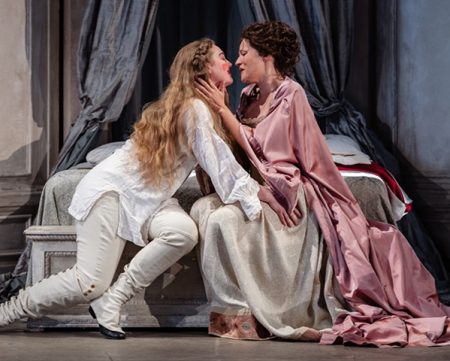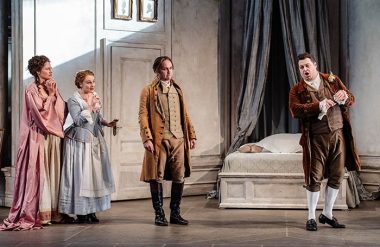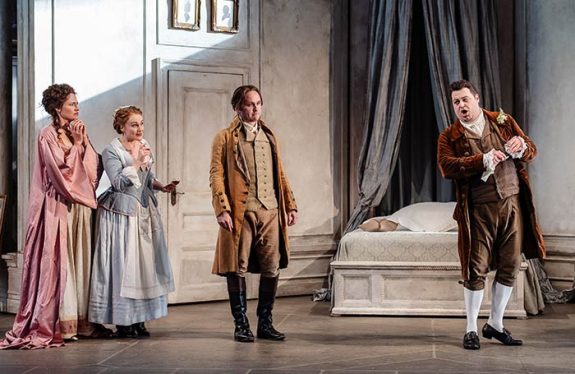 United Kingdom Garsington Opera 2024 [2] – Mozart, Le nozze di Figaro: Soloists, Garsington Opera Chorus, Philharmonia Orchestra / Tabita Berglund (conductor). Garsington Opera at Wormsley, 1.6.2024. (CR)
United Kingdom Garsington Opera 2024 [2] – Mozart, Le nozze di Figaro: Soloists, Garsington Opera Chorus, Philharmonia Orchestra / Tabita Berglund (conductor). Garsington Opera at Wormsley, 1.6.2024. (CR)

Production:
Director – John Cox
Revival director – Bruno Ravella
Designer – Robert Perdziola
Lighting designer – Malcolm Rippeth
Choreographer – Kate Flatt
Revival choreographer – Alex Gotch
Chorus director – Jonathon Cole-Swinard
Cast:
Figaro – Joe Chalmers
Susanna – Claire Lees
Count Almaviva – Rafael Fingerlos
Countess Almaviva – Samantha Clarke
Cherubino – Bethany Horak-Hallett
Bartolo – Neal Davies
Marcellina – Susan Bickley
Basilio – Paul Nilon
Curzio – Bradyn Debysingh
Antonio – Frazer Scott
Barbarina – Stephanie Hershaw
This is the third revival of John Cox’s production of Mozart’s perennial opera for Garsington, and it still does the job well as an essentially traditional and clear execution of the work as Mozart and da Ponte intended. That is to say, it is set at the time of composition (which came only a few years after the play by Beaumarchais on which it is based) and so serves as an effective introduction to the work, with its various twists and turns of plot, and an undemanding but rewarding experience on a summer’s evening.
The basic layout faithfully charts the course of the ‘crazy day’, from early on to night, just as the performance begins in summer light (or should do if the weather isn’t overcast!) and ends in darkness in the garden of Almaviva’s palace where the characters’ disguises are exploited, and the deceptions eventually unmasked. The layers of the palace are progressively stripped back for each act, starting off with a claustrophobic sense of the intrigue, desires, and vendettas being hatched, and ending in the ‘cool air’ of the garden, just as it is observed in the opera’s libretto that Almaviva’s (disingenuous) repeal of the old feudal droit de seigneur is a return to the natural order of things.
More than in most theatres, the atmosphere of the nocturnal garden is atmospherically rendered here with the entire back wall of the stage representing its green boughs and shades, essentially an extension of the real gardens that lie on either side of the clear glass panels of the auditorium at the Wormsley Estate. As such, we become entirely immersed in that return to nature – as though the original Fall in the Garden of Eden is reversed, and which Mozart surely meant to imply by the Countess’s divine proclamation of forgiveness at the end, having already had her quote the Agnus Dei of the ‘Coronation’ Mass in her ‘Dove sono’. It is surely telling, too, that in parallel with this return to nature, as the Count becomes more mired in his hypocrisy and moral depravity, he becomes more formally dressed up and artificial in appearance, pent up by status, rights, and custom, as he appears first in dressing gown, then everyday attire, followed by formal court dress in Act III, surrounded ominously by a whole gallery of portraits of forbears and worthies from a century or so before, in the hands of the Spanish and Italian masters.

Bruno Ravella’s revival direction oversees a clear realisation of the action on stage, and good pointing up of interpersonal detail, though the singers themselves could acquit themselves with more alacrity in their acting. They seem curiously muted as they interact with each other, rather than really sparking off a tense, exciting drama. That may partly be due to the fairly measured account of the score from Tabita Berglund, making her debut in any Mozart opera. Certainly, it is welcome to hear Mozart largely free from the increasing fashion to subject his music to the tempos of zippy, historically informed performance practice, so that melodies within the Philharmonia Orchestra’s textures here often emerge with the lyricism of human voices (though vibrato is generally kept in check, so sonorities are thin as often as not). That generally works well in the slower or more reflective numbers, above all the Countess’s two arias. But it works against the building up of tension in more dynamic numbers, such as Bartolo’s vengeance aria, or the miraculously symphonic sequence of the second act finale. The recitatives tend to be somewhat deliberate too in musical and dramatic terms, even if that helps to make the plot clearer.
Joe Chalmers replaced David Ireland in the lead role on this occasion, and after the briefest of unsteady starts, his performance soon fell into place with warm geniality, complemented by Claire Lees’s lively, voluble Susanna. Samantha Clarke is undoubtedly the star of the show as the Countess, with the impressive dignity and control of her singing, especially in ‘Dove sono’; Rafael Fingerlos’s Count exhibits a similar calm authority, though tends to lack urgency. Bethany Horak-Hallett displays winning charm and vigour as the impish Cherubino, sustaining ‘Voi che sapete’ with sparkle despite its relaxed tempo, and is well matched by Stephanie Hershaw’s sprightly Barbarina, whose ‘L’ho perduta, me meschina’ at the opening of Act IV is all the more moving for its graceful understatement.
Neal Davies is an avuncular Bartolo and could invest ‘La vendetta’ with more grit and rage, while Susan Bickley is a touch squally as Marcellina. The cast is rounded out by good characterful performances from Paul Nilon, Bradyn Debysingh, and Frazer Scott in the smaller roles of Basilio, Curzio, and Antonio.
Curtis Rogers
